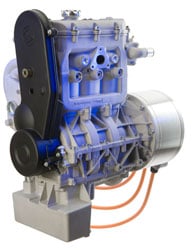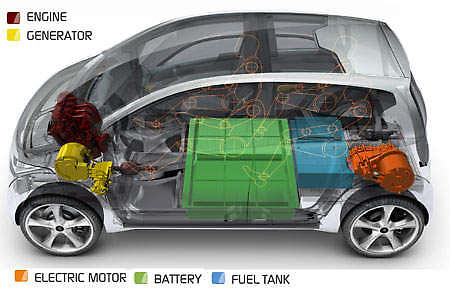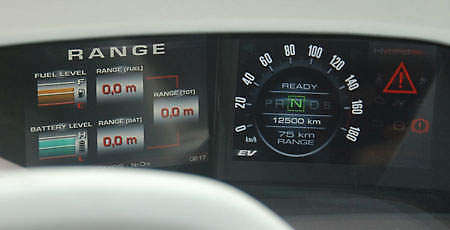 Let’s have a look at the very heart of the Proton EMAS Concept cars – the Lotus Range Extender Engine. There has been a lot of concerns from readers about the range which has been rated at 50km. First of all, the car is still a concept at this point of time, so these figures are generally quite meaningless unless the car gets closer to production.
Let’s have a look at the very heart of the Proton EMAS Concept cars – the Lotus Range Extender Engine. There has been a lot of concerns from readers about the range which has been rated at 50km. First of all, the car is still a concept at this point of time, so these figures are generally quite meaningless unless the car gets closer to production.
Concept cars are generally done as a ‘what if’ exercise and to gauge public perception and interest before moving ahead with the production version. This is why the one big question put forth at the Proton Concepts microsite is “would you like this to be the future of Proton”. According to Datuk Syed Zainal, it may take another 2 years before we can see a production version of the Proton EMAS on the roads.
But in any case, one of the most common comparisons in the comments so far is between the EMAS and the Mitsubishi i-MiEV. After all, the i-MiEV is somewhat similar – raised floor, compact size, rear motor and rear wheel driven. But the key difference between the two cars is that the i-MiEV is a pure electric car while the Proton EMAS Concept is a series-hybrid. But what exactly does series-hybrid mean? Does it mean it is not an electric car thus is not as ‘clean’ as an i-MiEV?

A series hybrid is basically an electric car, as long as you have enough juice in the battery packs for the electric motor to function. The Proton EMAS Concept has a range of 50km, which is shorter than the i-MiEV’s 160km range. But note that it isn’t an apple to apple comparison – the i-MiEV’s 160km range is calculated based on the Japanese 10-15 urban mode driving cycle, while Proton’s 50km range is not specified. It might be a mixed mode range or a ‘best effort’ range.
The difference is range can be quite easily explained – it is simply because the i-MiEV has a larger battery. It needs to have a larger battery because the battery is its only source of energy. Once you’re out of juice, you’re a sitting duck. With the Lotus Range Extender system, you do not need to have such a large battery – only one that is large enough to complete most city trips. That means less weight and less cost in terms of battery costs. Let’s say your office is about 15km to 20km from your home. You’ll hopefully be able to complete a to and fro trip on a single charge. When you get home, you plug the EMAS into your wall socket again to fully charge it up (3 hours on our 240V voltage – longer in 120V countries), and repeat the cycle the next day.

What happens when you need to travel further than 50km? The internal combustion engine will turn on and run to generate power. Because it only generates power and does not drive the wheels, Lotus can optimize it to run only at certain RPM points, so there is no need for costly variable valve timing, or this or that. The engine is a very simple 1.2 litre 3 cylinder single cam engine with only 2 valves per cylinder and a 10.0:1 compression ratio. It does not have to be built to withstand high RPM speeds so it can be lighter and cheaper to manufacture. The Range Extender engine only runs at 2 points – 1,500rpm and a higher 3,500rpm when you need to generate power a little faster. Peak torque is 107Nm at 2,500rpm, while peak power is quoted at 51hp at 3,500rpm.
Thus the Proton EMAS is hybrid in the sense that the electricity that its electric motor requires can be obtained through 2 ways – either a wall socket, or by the range extender engine burning fuel to generate electricity. As long as you do not exhaust the 50km battery capacity, your EMAS is technically as good as an electric vehicle and there won’t be any exhaust gas coming out of your exhaust pipes. But we don’t know yet how the battery management system works so the range extender engine might kick in earlier to ensure the battery does not get too weak in order to preserve battery life.
What I want to know now is how efficient the engine is in burning petrol to generate electricity. How many km can the car go on the electricity generated by 1 litre of petrol? That will give us a “km per litre” measurement for when the car is not running on plug-in power. Look after the jump for 4 pix of the engine.
[zenphotopress number=999 album=908]
Looking to sell your car? Sell it with Carro.











AI-generated Summary ✨
The comments on the blog post largely express optimism and anticipation for Proton's EMAS hybrid system, viewing it as an innovative and promising development in Malaysian automotive technology, with many supporting local industry efforts. Several comments highlight the system's potential for environmental benefits, affordability, and technological advancement, comparing it favorably to foreign hybrid models like the Chevy Volt or Toyota Prius. However, skeptics raise concerns about the readiness of the technology, practicality issues such as charging infrastructure, car pricing, and Malaysian market conditions. Some critics accuse others of patriotism-related biases or off-topic bashing. Overall, the sentiment balances excitement for innovation with caution about implementation challenges, emphasizing the need for quality, cost-effectiveness, and national pride in local automotive progress.